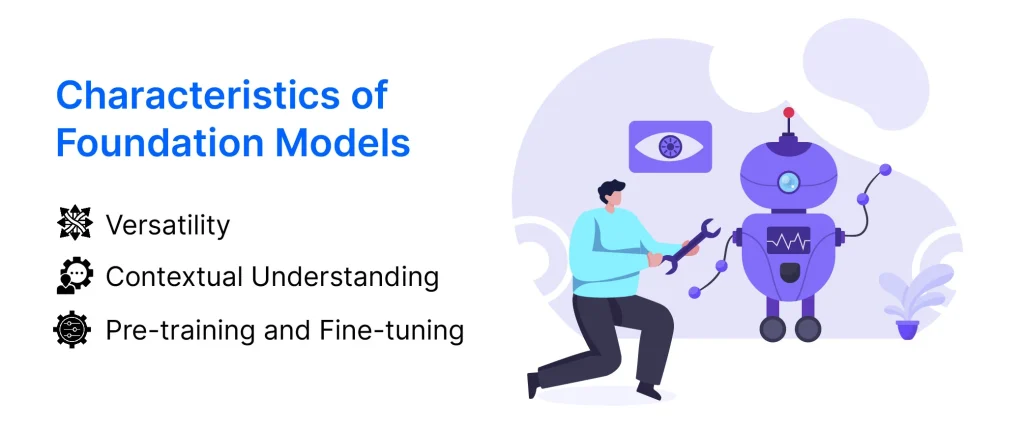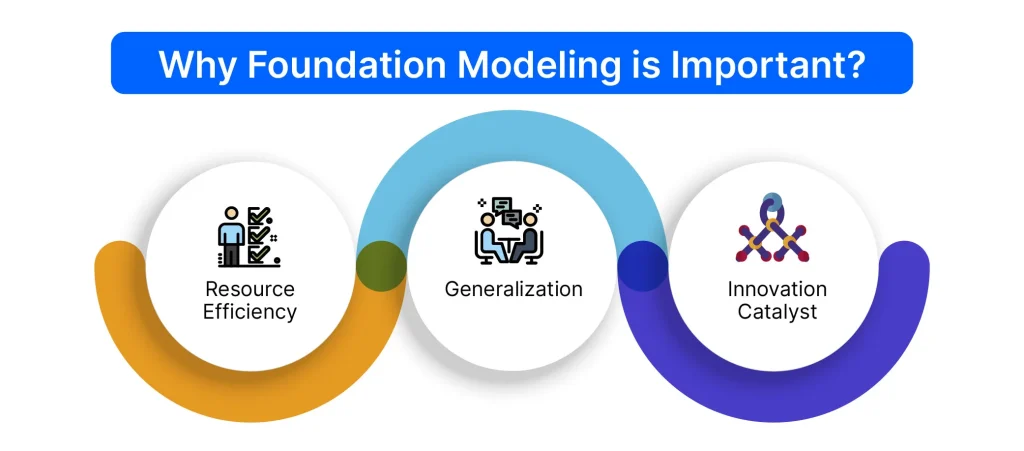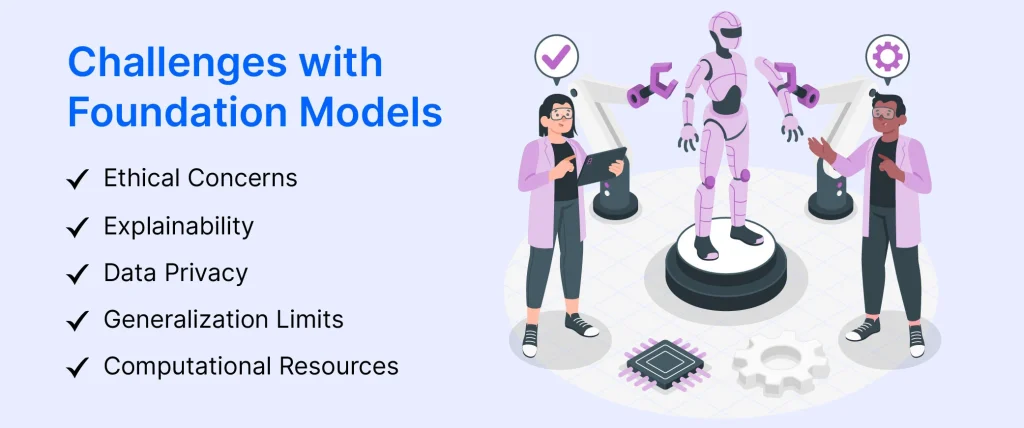What are Foundation Models?
Foundation models refer to fundamental and versatile pre-trained models that serve as the building blocks for various natural language processing (NLP) and computer vision tasks. These models are trained on massive datasets to learn the intricacies of language or visual patterns and can then be fine-tuned for specific applications.
In the context of natural language processing, foundation models are typically large-scale transformer-based architectures that excel at understanding and generating human-like text. Examples include models like OpenAI’s GPT-3 (Generative Pre-trained Transformer 3) and BERT (Bidirectional Encoder Representations from Transformers). These models learn contextual relationships between words and sentences, making them adept at tasks such as language translation, sentiment analysis, and question answering.
Large language models (LLMs) fall into a category called foundation models. Language models take language input and generate synthesized output. One of the best examples of this is the GPT-n class of LLMs. The announcement of potent LLMs like GPT-4 sparked debates about artificial intelligence, or the idea that AI is capable of everything. Many applications powered by GPTs have been developed since its release.
For computer vision, foundation models are designed to understand and interpret visual data. They can be pre-trained on diverse image datasets and then adapted for specific tasks like image classification, object detection, and image generation. Notable examples include vision models like OpenAI’s CLIP (Contrastive Language–Image Pre-training) and Google’s Vision Transformer (ViT).
The versatility of foundation models lies in their ability to capture intricate patterns and relationships in data during pre-training, allowing them to generalize well to a range of downstream tasks. By fine-tuning these models on specific datasets, developers can harness their powerful features for a variety of applications, saving time and resources compared to training models from scratch.
Foundation Models in Generative AI?
Foundation models are the guiding force shaping the future of Generative AI, unlocking boundless potential in intelligent content creation.Foundation models are the bedrock of Generative AI, designed to comprehend the complexities of language and visual patterns. In the context of natural language processing, they are large-scale transformer-based architectures that learn contextual relationships in text, allowing them to generate coherent and contextually relevant content. Examples include GPT-3 and BERT.
On the visual front, foundation models like CLIP and ViT excel in understanding and interpreting visual data. These models can be pre-trained on vast image datasets and fine-tuned for specific tasks such as image classification and object detection. Navigating the Journey of Foundational Models – Explore the evolutionary path of foundational models from their basic principles to groundbreaking advancements in AI.
Characteristics of Foundation Models
Foundation models, at the core of AI development, exhibit key characteristics such as scalability, adaptability, and robustness. These models serve as the building blocks for diverse applications, providing a solid framework for innovation.

1. Versatility
Foundation models showcase versatility by learning diverse patterns during pre-training, making them adaptable to a wide range of downstream tasks without extensive retraining.
2. Contextual Understanding
In NLP, these models capture the contextual nuances of language, understanding relationships between words and sentences. In computer vision, they grasp intricate visual patterns.
3. Pre-training and Fine-tuning
The models undergo pre-training on large datasets, followed by fine-tuning on specific tasks. This dual-stage process contributes to their effectiveness in various applications.
Why Foundation Modeling is Important?
Foundation modeling is crucial as it establishes the groundwork for robust AI systems. It provides a solid framework for innovation, enabling the development of advanced applications. The integration of an AI foundation model into a learning management system enhances personalized education by leveraging advanced natural language processing capabilities to tailor content delivery and provide adaptive learning experiences for students.
By setting the standards and principles, foundation modeling ensures scalability, adaptability, and efficiency, laying the essential groundwork for the successful evolution and deployment of artificial intelligence technologies. Foundation modeling is pivotal for several reasons:

1. Resource Efficiency
Pre-trained models save computational resources and time, as developers can leverage existing knowledge for specific applications.
2. Generalization
The models generalize well to diverse tasks, showcasing their ability to understand and adapt to different data patterns.
3. Innovation Catalyst
Foundation models serve as catalysts for innovation, enabling developers to focus on task-specific nuances rather than starting from scratch.
How do Foundation Models Work?
Foundation models in the realm of artificial intelligence operate on a sophisticated two-stage process, combining pre-training and fine-tuning to achieve their remarkable capabilities.
1. Pre-Training
In the initial pre-training stage, foundation models embark on an extensive learning journey. Large-scale datasets, rich with linguistic or visual information, serve as the training ground. For natural language processing (NLP) models like GPT-3 and BERT, the models immerse themselves in a vast corpora of text, absorbing the contextual relationships between words and sentences. This phase equips the model with a nuanced understanding of language, allowing it to predict the next word in a sentence, fill in missing pieces of text, and generate coherent paragraphs.
In the case of computer vision models such as CLIP and ViT, the pre-training stage involves exposure to diverse image datasets. The models learn to discern patterns, shapes, and features within images, forming a foundational understanding of visual data. This stage is crucial for enabling the models to recognize objects, understand scenes, and perform tasks like image classification.
2. Fine-Tuning
Having acquired a comprehensive understanding of contextual nuances, foundation models proceed to the fine-tuning stage. This is where their adaptability and versatility shine. The pre-trained model, now a knowledge-rich entity, is fine-tuned on task-specific datasets. For instance, in NLP, fine-tuning may involve training the model on sentiment analysis or question-answering datasets. In computer vision, fine-tuning could be directed towards tasks like object detection or image segmentation.
Fine-tuning refines the model’s capabilities, aligning it with the intricacies of the targeted application. This approach not only saves significant computational resources but also enables rapid adaptation to specific tasks. It showcases the models’ ability to generalize learned patterns to new and diverse scenarios, making them effective tools across a spectrum of applications.
In essence, the workings of foundation models are a testament to their adaptability and learning prowess. The combination of pre-training and fine-tuning positions these models as powerful instruments, capable of comprehending and excelling in tasks spanning natural language understanding, image recognition, and beyond.
What can Foundation Models Do?
Foundation models represent a pinnacle in artificial intelligence, possessing diverse capabilities that stem from their pre-trained understanding of language or visual patterns. These models, such as GPT-3, BERT, CLIP, and ViT, showcase a broad range of functionalities across various domains.
1. Natural Language Processing (NLP)
Foundation models are adept at generating contextually relevant and coherent text. This capability is harnessed in content creation, chatbots, and creative writing applications.
Leveraging their understanding of context, these models excel at answering questions, making them valuable in virtual assistants and information retrieval systems.
Their contextual understanding enables accurate language translation, facilitating communication across linguistic barriers.
2. Computer Vision
Models like CLIP can accurately classify images, distinguishing between various objects, scenes, or concepts within pictures.
Recognizing and locating specific objects within images, these models contribute to applications like autonomous vehicles, surveillance systems, and robotics. They can comprehend and respond to questions about visual content, enhancing interactive interfaces and accessibility.
3. Creative Content Generation
GPT-3, for instance, can generate artistic pieces, poetry, and even code snippets, showcasing its creative versatility. These models can craft compelling narratives, aiding content creators and storytellers.
4. Task Automation
Foundation models can summarize lengthy text passages, streamlining information extraction. They facilitate data extraction and processing, enhancing efficiency in data-intensive tasks.
5. Custom Applications
The versatility of foundation models allows for customization to specific applications, from legal document analysis to sentiment analysis in customer feedback.
Examples of Foundation Model Applications
Foundation models have made significant strides in revolutionizing various industries, demonstrating their versatility and adaptability. Here are examples of how these models are applied in real-world scenarios:

Healthcare
Foundation models contribute to medical research by analyzing vast volumes of textual data, aiding in disease diagnosis and treatment recommendations. They assist in extracting valuable insights from medical literature, enabling healthcare professionals to stay updated on the latest advancements. The connection of AI chatbots in healthcare and foundation models promises a future where technology not only supports medical practitioners but also contributes to more personalized and efficient patient care.
Finance
In the financial sector, foundation models play a crucial role in risk assessment, fraud detection, and investment strategies. They analyze vast datasets, discerning patterns that help in predicting market trends and identifying potential risks.
Content Creation
GPT-3 and similar models are employed in content creation, generating human-like text for articles, blogs, and marketing materials. They assist writers in brainstorming ideas, crafting creative pieces, and automating parts of the content creation process.
Customer Support
Foundation models power virtual assistants and chatbots, enhancing customer support services. They can understand and respond to user queries, providing instant assistance and improving the overall customer experience.
Autonomous Vehicles
Computer vision foundation models contribute to the development of autonomous vehicles. They can recognize and interpret visual information from the vehicle’s surroundings, enabling safe navigation and decision-making.
Challenges with Foundation Models
While foundation models offer transformative applications, they also face challenges that need careful consideration:

1. Ethical Concerns
The use of foundation models raises ethical questions, particularly regarding biases present in the training data. Ensuring fairness and mitigating biases is an ongoing challenge.
2. Computational Resources
Training and fine-tuning large-scale foundation models demand substantial computational resources, posing challenges in terms of energy consumption and infrastructure requirements.
3. Explainability
Foundation models, especially very large ones like GPT-3, are often seen as “black boxes” due to their complexity. Understanding the reasoning behind their decisions is challenging, which can be a concern in critical applications where transparency is essential.
4. Data Privacy
Foundation models require access to vast amounts of data, raising privacy concerns. Striking a balance between utilizing data for training and safeguarding individuals’ privacy is a persistent challenge. Foundation models are trained on vast amounts of diverse data, potentially including sensitive information. There are concerns about privacy and security, especially if the models are fine-tuned on proprietary or confidential datasets.
5. Generalization Limits
While foundation models excel in generalization, they may struggle with out-of-distribution scenarios. Ensuring robust performance across diverse situations is an ongoing research focus.
Addressing these challenges is essential to unlocking the full potential of foundation models and harnessing their benefits responsibly across diverse applications. As the field advances, continuous efforts are made to overcome these obstacles and refine the deployment of foundation models in the real world
How IntellicoWorks Can Help?
IntellicoWorks is your dedicated partner in navigating the complexities of AI and technology. Our comprehensive services are designed to address diverse needs, fostering innovation and driving success across industries. Recognizing the importance of making advanced AI capabilities accessible, IntellicoWorks develops user-friendly interfaces and applications that allow individuals without technical backgrounds to benefit from the power of AI foundation models. Our latest project involves implementing an advanced object detection model, leveraging state-of-the-art algorithms to enhance accuracy and efficiency in identifying and classifying objects within complex visual data.
IntellicoWorks provides comprehensive training and support to help your team integrate AI solutions seamlessly into your workflow. From onboarding to ongoing support, we are dedicated to ensuring a smooth and successful implementation of AI technologies in your organization. As the demand for intelligent solutions grows, our AI development services offer a comprehensive suite of capabilities, distributed machine learning, natural language processing, and computer vision.
Conclusion
AI foundation models play a crucial role in the current landscape of artificial intelligence. Their ability to generalize knowledge and perform diverse tasks has led to significant breakthroughs. However, careful consideration of ethical implications and ongoing research is necessary to ensure the responsible development and use of these powerful tools. As the AI field continues to evolve, understanding and harnessing the potential of foundation models will be essential for shaping the future of artificial intelligence.
Boost Efficiency and Innovation with Our AI Development!
Frequently Asked Questions
AI foundation models are large-scale machine learning models pre-trained on extensive datasets to understand and generate human-like text, images, or other content. These models serve as the basis for a wide range of AI applications.
These models use deep learning architectures, such as transformers, for processing and understanding data. They undergo a pre-training phase on massive datasets, learning patterns and representations that make them adaptable to various tasks.
AI foundation models find applications in natural language understanding (sentiment analysis, text summarization), computer vision (object recognition, image captioning), and multimodal tasks (cross-modal retrieval, generating content based on textual prompts).
Challenges include ethical concerns related to bias, resource intensiveness in terms of computational requirements, interpretability issues, and concerns about security and privacy associated with the misuse of AI-generated content.
Addressing biases involves careful curation of training data, transparent model development practices, and ongoing efforts to detect and mitigate biases during model training and deployment.
Yes, AI foundation models can be fine-tuned for specific tasks by training them on domain-specific datasets. This allows the models to specialize in particular applications while retaining the general knowledge acquired during pre-training.


